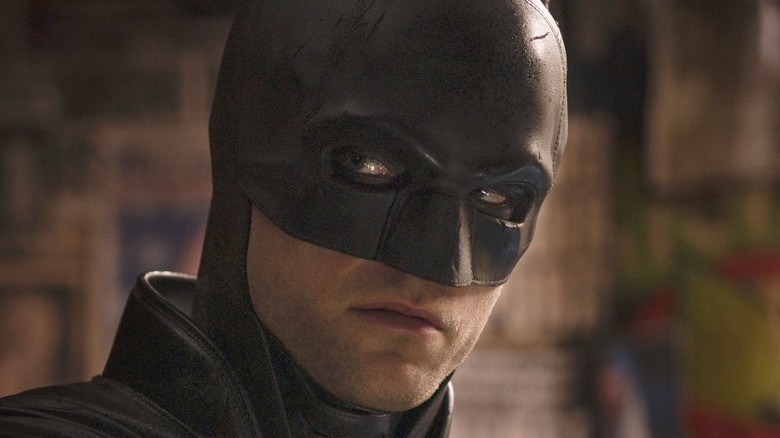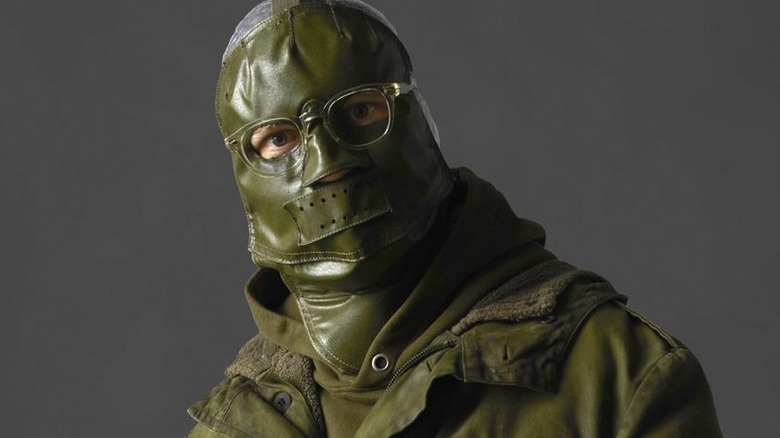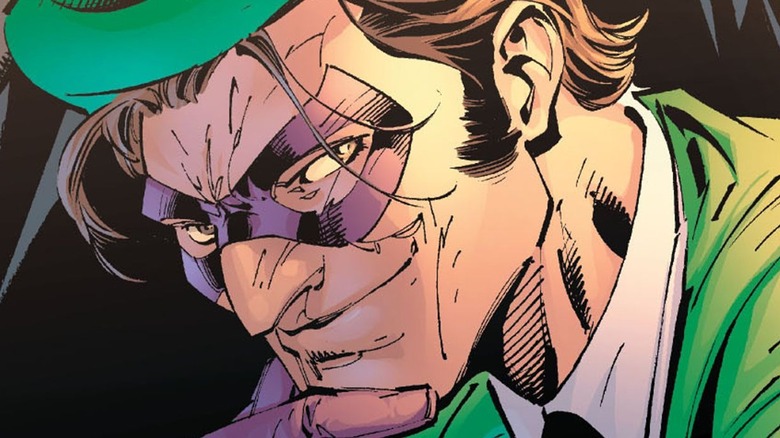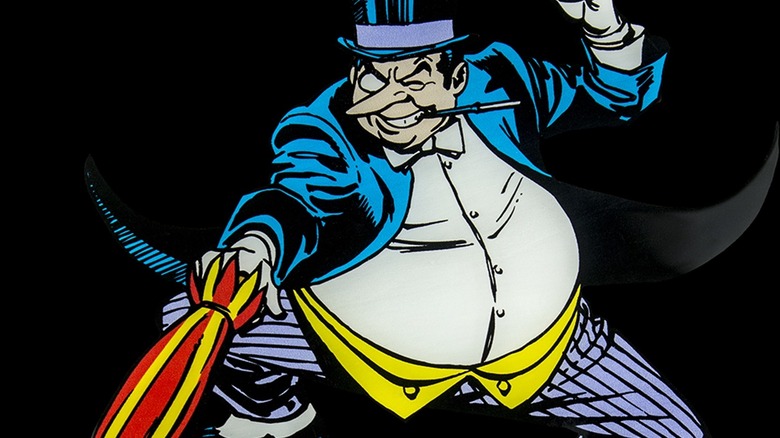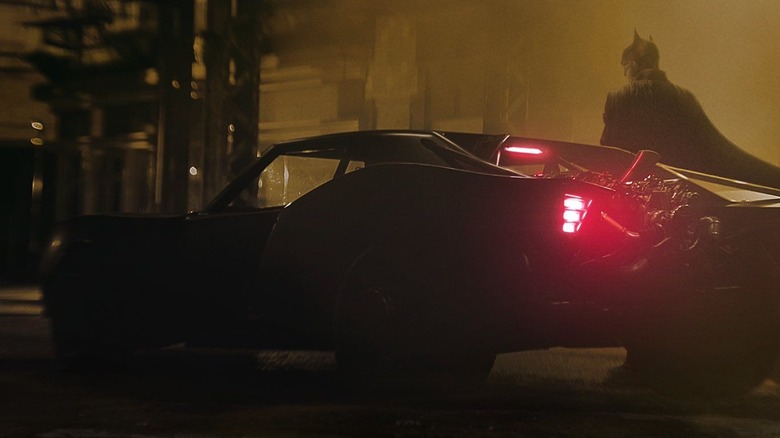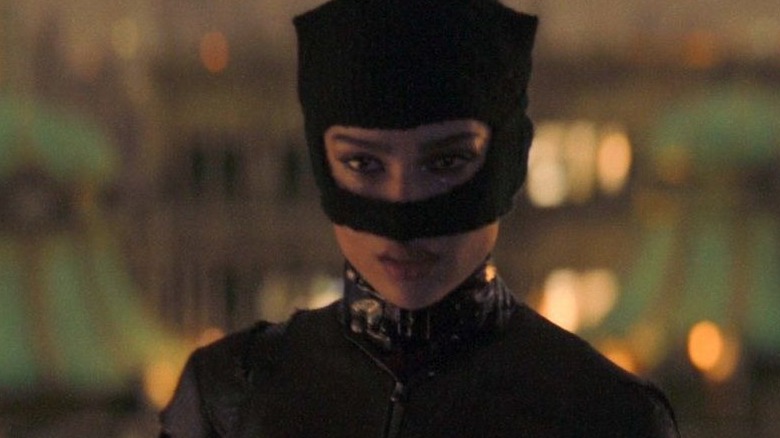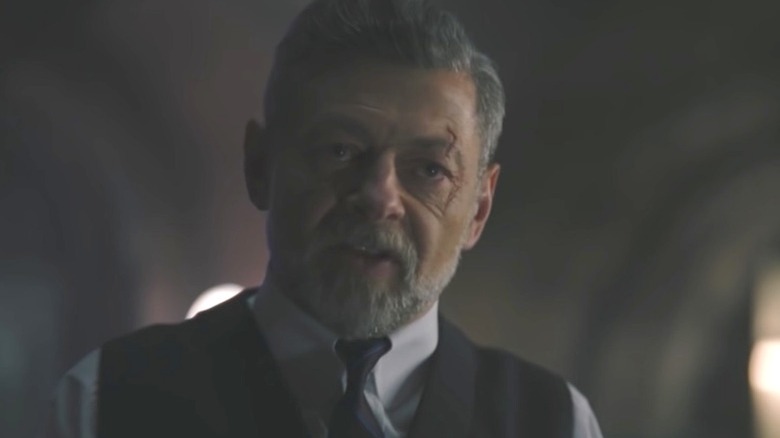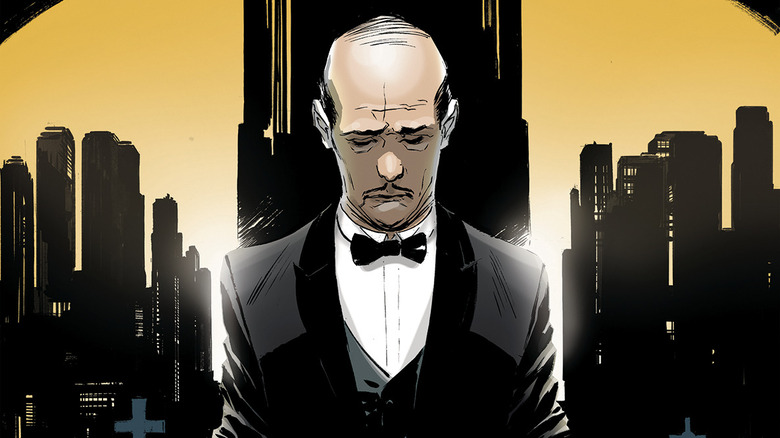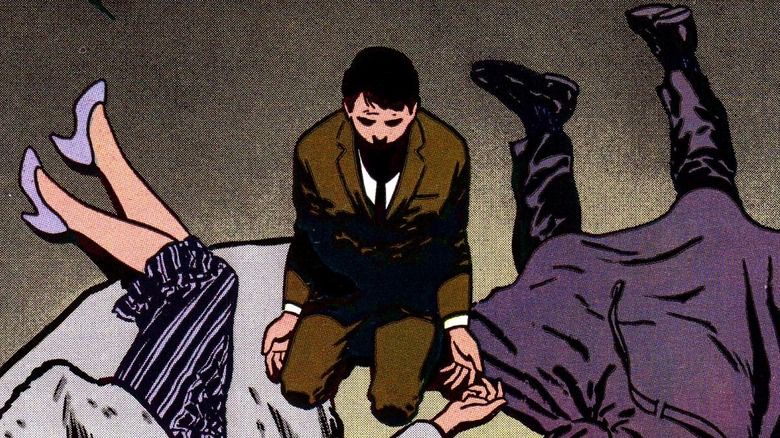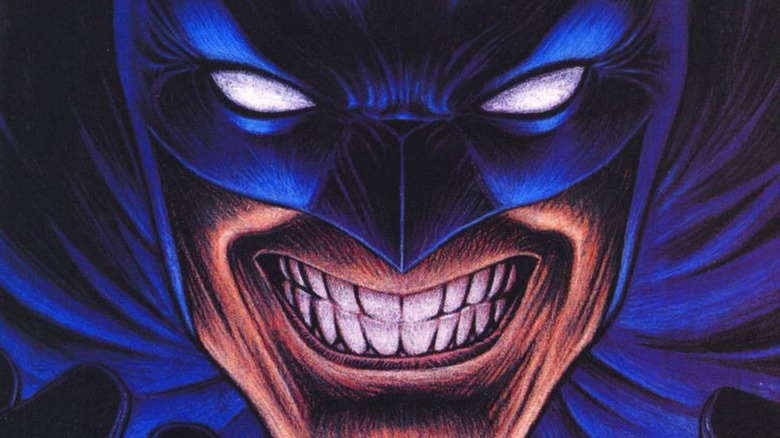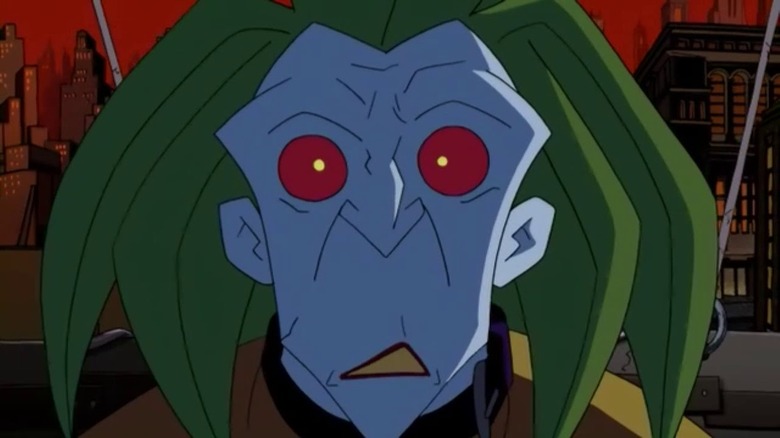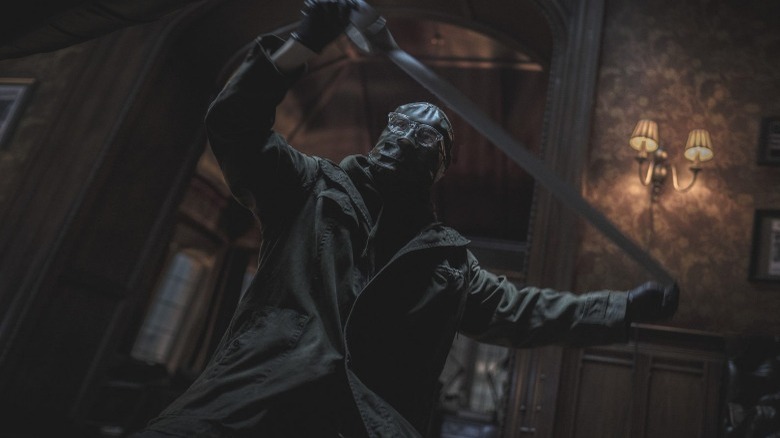Moments In The Batman That Make No Sense
Spoiler Warning: This article contains major plot points from "The Batman."
"The Batman," directed by Matt Reeves ("War for the Planet of the Apes") and starring Robert Pattinson ("The Lighthouse") as the eponymous Caped Crusader, has finally decided to jump from the shadows and onto the big screen. It boasts an impressive all-star cast as well, with Paul Dano ("Little Miss Sunshine") as a Zodiac-inspired serial killer version of The Riddler, Colin Farrell ("After Yang") as a mafioso Penguin, Andy Serkis ("The Lord of the Rings") as a tougher-than-usual Alfred, and Zoë Kravitz ("Kimi") as a badass Catwoman, among others.
There have been many versions of the Batman over the years, with this being the ninth live-action theatrically released Batman film since 1966 (unless you count his cameo in "Suicide Squad"), and the 11th if you count animated versions like "Mask of the Phantasm" and "The LEGO Batman Movie." For what it's worth, "The Batman" definitely brings some new things to the table. For one, it's the first Batman film to actually treat Batman as "The World's Greatest Detective," while containing the most directly noir-inspired narrative. Furthermore, it finally admits that Batman wears eyeliner (no more goofy jump cuts like in "Batman Returns").
But the film does also unfortunately stumble in a lot of places as well. What exactly are the moments that have made fans the most upset?
The Riddler's goofy mask
Paul Dano's deranged, but still nonetheless brilliant, take on the Riddler is certainly a highlight of "The Batman." He's at once menacing and sadistic, as well as simultaneously pitiable and neurotic. It's honestly the most faithful interpretation of the character in that regard (if not necessarily the most fun).
Having said that, what is not so faithful is his new homeless-chic costume. This, however, is mostly forgivable given director Matt Reeves' grounded take on the universe ... but his goofy, try-hard Zodiac-inspired gimp mask is much less so.
That's mainly because it's so different from any comic book version of the character, who –- while there have been many interpretations over the years, from spandex-wearing trickster to green-suited methodical genius — has always showed his face, with only a domino mask hiding his identity. Heck, Dano's thick glasses seemed like a good "grounded" version of a domino mask anyway.
To be fair, in the film, the Riddler wears the mask (outside of the aforementioned and honestly kind of tacky Zodiac reference) because he needs to hide his identity while streaming his Jigsaw-esque crimes to the internet. Still doesn't make the mask any less ridiculous though.
The Riddler doesn't figure out Batman's identity
In many ways, the Riddler is indeed one of Batman's most clever and intelligent villains. It's because he thinks at least 10 or more steps ahead of anyone else (oftentimes even Batman himself for most of any given story, until obviously the end), and is usually undone solely due to his own hubris rather than any lack of innate brilliance.
Also, in the comics (most notably the Batman event series "Hush," which ran from 2002 to 2003), the Riddler finally finds out Batman's true identity as the billionaire trust fund baby Bruce Wayne. Even Jim Carrey's over-the-top, orange flat-topped jokester version found out Batman's secret identity in 1995's "Batman Forever."
So it's somewhat disappointing (exacerbated by the ominous marketing campaign) that Paul Dano's Riddler can't connect the dots and discover that Batman is in fact goth loner Bruce Wayne (especially considering how much Riddler apparently loathes him, and presumably exhaustively researches him).
To be clear, he also doesn't really care who the Batman is, so he doesn't seek his identity out. It just seems, given the kind of research he does for all his other victims, that he would uncover that fact regardless of intent.
Where's Penguin's umbrella?
Ever since 1he Penguin's introduction in 1941's Detective Comics #58, in the story "One of the Most Perfect Frame-Ups," he's had his trusty and iconic weaponized umbrella at his disposal. In fact, every incarnation of The Penguin has had some form of umbrella weapon at this point. Which makes sense, given that The Penguin's umbrella is probably his most definable trait outside his top hat and overly pointy nose. Even Tim Burton's barely-faithful version in "Batman Returns" doesn't get that part wrong (despite getting almost everything else wrong).
However, while it makes some sense to ditch the top hat (a fashion statement of a bygone era), to remove the umbrella entirely seems a step too far. Especially considering it wouldn't be too hard to modernize — he's a mafia enforcer who could have used it as a way conceal a shotgun and try to blast Batman during his initial interrogation or something. It doesn't have to turn into a helicopter that makes him fly (though that would have been cool).
Even worse, there's a scene set during a heavy downpour of rain, and while his goons have umbrellas, the Penguin himself doesn't! What the heck?! That's just rubbing salt in the wound at that point.
Batmobile car chase is perfunctory
Pretty much every Batman film at this point has had a prerequisite Batmobile car chase scene in it. It's happened so much that it's become part of the Batman movie formula, like James Bond traveling to an exotic location or Rob Schneider playing a racist stereotype in a Happy Madison film.
And why not? The Batmobile is probably the hero's most famous and versatile weapon utilized in his fight against crime, and, furthermore, car chases are always cool, and have been an action staple since the silent movie era.
The Batmobile car chase in "The Batman" is no exception. It's got some neat shots, big explosions, and the twisted metal and screeching tires you'd expect. However, it's also ... perfunctory and mediocre. It doesn't help that it's filmed at night, with a lot of close-up angles (making spatial orientation difficult to discern), and uses infuriatingly rapid-cut edits (further abstracting spatial awareness). Worse, it's filmed in boring locations, like a rusted scrap yard and highway. Yawn.
Compare that to the spectacular Tumbler chase scenes in "Batman Begins" or "The Dark Knight," or even the insane car chase in "Batman Forever" where the Batmobile drives up the side of a building. There's nothing close to being that imaginative in "The Batman" chase, unfortunately, and it suffers in comparison because of it.
Catwoman gets declawed
Catwoman is one of the most iconic villains (or, in her case, antiheroes) in Batman's entire rogues gallery, and arguably his most healthy romantic relationship (which is saying a lot). So it makes sense that Matt Reeves would want to include her in his new reboot. Furthermore, Zoë Kravitz's portrayal of Catwoman, aka Selina Kyle, is an instant classic. Kravitz gives Kyle a sense of real strength and drive, as well as a calloused but innate sensitivity that slowly emerges throughout the film without ever sacrificing her edge or determination. Not only that, but she also has the character's slinky, feline movement down pat, and actually looks like she can believably kick the butts of goons two to three times her size.
So it's such a disappointment that the script lets her down at every turn. Sure, she gets to wail on some faceless thugs with some flashy moves, but in every critical moment –- whether it's getting subdued by Batman in their introduction, beaten down by John Turturro's Carmine Falcone (an actor, and character, not really known for their fighting prowess), or needing to be saved in the climax from Riddler's army like a damsel-in-distress, Catwoman never really gets a chance to come out on top.
This unfortunately calls to mind the "Strong Female Character" trope, where a woman gets to be strong and cool, until she inevitably fails and the male hero has to actually do all the real work. It's unfortunate, to say the least.
Batman is mean to Alfred
Unlike the previous entries so far, this one is less "something wrong with the movie that fans are upset about," and more "something in the narrative that was meant to purposely upset fans." In the new film, Bruce and Alfred have a much more fraught and tense relationship than they normally do. While Alfred obviously cares about Bruce, and is even instrumental in helping decode The Riddler's complicated ciphers, Bruce doesn't seem to share that affection.
In fact, in their first scene together, Bruce snaps at Alfred for trying to get him to do stuff for his company, even saying "You're not my father" like an angsty teen, which obviously hurts Alfred. Later on in the film, Bruce even chides Alfred for his Wayne family cufflinks, implying that Alfred isn't worthy of the Wayne name.
This, of course, is upsetting because we like to see Alfred and Bruce have affection each other, and Bruce's dismissiveness to his devoted butler/father-figure isn't fun to watch. Again, to be clear, this is all part of Bruce's character arc of opening up and becoming less consumed by vengeance, as well as reconciling with his father's legacy. So it's not a mistake or even bad storytelling at all. Still stings though.
Alfred almost dies
Spoiler Warning: This section contains a major plot point from "Spider-Man: No Way Home."
Like the previous entry, watching Alfred get consumed by flames and presumed dead is less "something wrong with the movie to be upset about" and more "it was upsetting for fans to see Alfred in that dire of a position." Worse is Bruce realizing that the Riddler planned to kill Bruce Wayne, with Alfred as potential collateral damage, and that his race against time was futile because the bomb the Riddler sent had already exploded hours earlier.
This scene is especially upsetting, given what happened to Aunt May in last year's "Spider-Man: No Way Home." She was another character in a superhero blockbuster thought to be safe due to her longevity in the comics –- making her subsequent death that much more shocking and disheartening.
In this case, Alfred does turn out to have survived the Riddler's attack. Which is good, because the loss of Alfred might have been one too many unexpected deaths of beloved characters in such a short timespan.
Thomas Wayne revelation is half-baked
One of the most intriguing aspects of "The Batman" is how it repositions the morality of the Waynes — especially Thomas Wayne — and actually adds a bit of moral ambiguity and realism to this version of the universe.
In the film, it's revealed that Thomas Wayne was running for mayor before he was killed, and that during the campaign a reporter found out that Martha (whose maiden name was Arkham) had family baggage that could derail the election. Thomas then tried to bribe the reporter to back off. When he didn't, he asked mob boss (and old friend) Carmine Falcone to step in and take care of it. Which he did ... by killing the reporter.
This is great, because it gets into how the rich are often embedded in crime to maintain power (not always as explicitly as getting favors from mobsters –- though that too -– but also via embezzlement, exploitation, and bribes). Unfortunately, while it gestures towards a more complicated and frankly more interesting take on the Waynes' backstory, it's half-hearted and half-assed.
At one point, Alfred even defends Thomas Wayne, saying he was a good man because "he felt bad" about his mobster buddy killing an innocent person, essentially at his behest. Worse, the film thinks that's a good justification.
The Riddler might be right about how the world seems to care more about the rich's feelings, rather than the material conditions of those below them.
Batman uses Venom
One of the most iconic comic book arcs in Batman history is "Knightfall," which ran from 1993 to 1994. It was the introduction of Bane, a large, muscle-bound and luchador-masked villain who famously broke Batman's back over his knee.
Now, while Bane is often characterized as being a big, dumb brute, the Bane in the comics (and in "The Dark Knight Rises," where he was played by actor Tom Hardy) is actually a calculating tactician. His strength, however, is still formidable, and augmented by a chemical known as Venom –- a green liquid that is basically super steroids.
Curiously, there's a moment in the climatic action scene of "The Batman" that alludes to the existence of Venom in this universe. Batman is seen reeling from a shotgun blast to the chest, and eventually injects himself with green liquid that gives him a boost of strength to continue fighting and save the day. True, this could just be adrenaline, but the fact that it's so effective and makes him go berserk for a moment (almost killing a random Riddler henchman) –- not to mention that Batman has used Venom in the comics before –- seems deliberate.
It also seems too early to introduce that concept in this new Batman universe. Even in the film itself the revelation seemed unnecessary, especially considering the already three-hour runtime.
The new Joker is lame
It seems that every Batman adaptation for some reason feels the need to add the Joker. Sure, he's an important part of the character's mythos, but there are so many other crazy villains (like The Ten-Eyed Man!) that would be much more interesting to see in live-action at this point.
However, if you are going to do a new version of the Joker, you have to at least do it well. Unfortunately, this might be one of the weakest attempts at a reboot of the Clown Prince of Crime that we've seen yet — yes, possibly even worse than Jared Leto's Juggaloker, since Leto at least seemed to be putting in some effort. Meanwhile, actor Barry Keoghan ("Eternals") is very subdued in the role for some reason, appearing bored and almost embarrassed to perform the iconic laugh.
This, of course, is not to discredit Keoghan as a performer outright, as he has been phenomenal in many other projects before. This includes "The Killing of a Sacred Deer," where he was genuinely creepy and unsettling opposite fellow "The Batman" villain Colin Farrell. But that's not really The Joker's vibe. Or at least it shouldn't be.
The message is muddled
It's obvious while watching "The Batman" that writer-director Matt Reeves and co-writer Peter Craig are trying to say something with this film by discussing things like income inequality, rampant police corruption, systemic malfeasance, etc. That's all well and good — potentially noble even. The issue is: what actual statement are they making beyond "these things exist"?
Because the Riddler isn't wrong, really. The world is full of corruption, where the rich and powerful exploit the poor and marginalized with impunity. It's a legitimate problem. The anger is justified. It's so justified in fact, that the screenwriters had to concoct a far-fetched plan to drown Gotham so that his points can be easily ignored (a tactic used in other films like "Black Panther"). Even his and his followers' QAnon-coding is at odds with what his ideological leanings would more likely be (or, worse, the filmmakers are purposely conflating them).
The solution the film comes to seems to be reformation — to "regain trust in institutions," as said by Bella Real (played by Jayme Lawson), the brave, newly-elected, and progressive-coded mayor of Gotham at the end of the film. However, we've seen how reform doesn't fix police corruption and that even progressives will still play realpolitik with people's lives.
This wouldn't be a problem in a less grounded universe — you're not questioning the harsh realities in a Tim Burton movie where cathedrals are the height of skyscrapers. But in this film, it just comes off as pandering and wrong-headed, even if well-intentioned.
